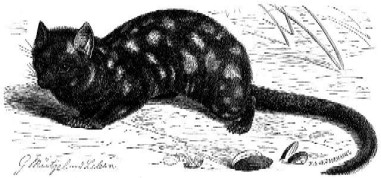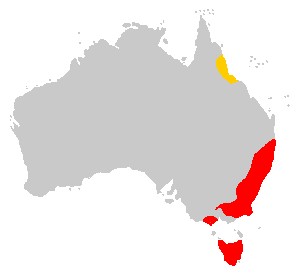
November 3, 2006
Click on the Eastern Quoll (Dasyurus viverrrinus) above for a full sized image.
"Extinct" marsupial may be alive and well – NSW
Rebecca Lang
A Hawkesbury (NSW, Australia) resident may have stumbled upon one of the most exciting zoological finds of the decade – a small marsupial previously thought to be extinct on Australia’s mainland.
East Kurrajong resident and Hawkesbury Gazette newspaper employee Nicole Palmer was driving along Roberts Creek Road recently when she spotted a couple of unusual-looking animals.
"There was two of them. One was smaller. I pulled up and the larger one kept hopping towards the car so I strated rolling back down the hill and honking my horn," she said.
"They were both dark brown with white spots around its jowl and neck area, 3-4 inches of the tip of its tail was white and it didn’t look like a tiger quoll, it was much smaller and less heavy."
From her description, NPWS ranger Vickii Lett and University of Western Sydney biologist Professor Rob Close believe Ms Palmer may have spotted two Eastern quolls.
Eastern quolls are about the size of domestic cats with pointed noses and soft fawn, brown or black-coloured fur broken up by white spots, and a bushy tail with a white tip.
They are much smaller than their cousins, the endangered Spotted-tail or ‘Tiger’ quoll, which has a coarse, reddy-brown coat with white spots and is half as big again as the eastern quoll.
The eastern quoll was last sighted on the mainland in the 1960s in the Sydney suburb of Vaucluse.
Since that time dogs, cats and people have encroached on the small marsupial’s habitat to the extent that they are now believed to be extinct on the mainland.
However, Eastern quolls remain prolific in Tasmania, preferring to live in dry grassland and forest bordering farm paddocks.
Ms Lett said National Parks would be acting on the sighting of the protected species.
"We’ll talk to Dr Rob Close at UWS and see what we can do," she said.
"In the meantime, we’d like residents to keep an eye out and if they see something unusual, take a picture of it with their camera or mobile phone.
"We’d also like people in the area to be careful about letting their dogs and cats roam around."
Dr Close, who recently urged residents to keep an eye out for signs of rare wildlife, said he was thrilled about the sighting.
"If it is in fact a true sighting, it’s very exciting," Dr Close said.
"There’s been a few sightings over the past few years, unverified, so it raises hopes that they are still around.
"If they can live in Vaucluse until the ’60s, you’d think there would be a chance they could survive in these more isolated places.
"Nobody knows what knocked the eastern quolls off. Disease was a possibility, and if that’s all over now, their numbers could be building up again."
The finding was made in late October.
Source: Hawkesbury Gazette, Wednesday, 1 November 2006

About Loren Coleman
Loren Coleman is one of the world’s leading cryptozoologists, some say “the” leading living cryptozoologist. Certainly, he is acknowledged as the current living American researcher and writer who has most popularized cryptozoology in the late 20th and early 21st centuries.
Starting his fieldwork and investigations in 1960, after traveling and trekking extensively in pursuit of cryptozoological mysteries, Coleman began writing to share his experiences in 1969. An honorary member of Ivan T. Sanderson’s Society for the Investigation of the Unexplained in the 1970s, Coleman has been bestowed with similar honorary memberships of the North Idaho College Cryptozoology Club in 1983, and in subsequent years, that of the British Columbia Scientific Cryptozoology Club, CryptoSafari International, and other international organizations. He was also a Life Member and Benefactor of the International Society of Cryptozoology (now-defunct).
Loren Coleman’s daily blog, as a member of the Cryptomundo Team, served as an ongoing avenue of communication for the ever-growing body of cryptozoo news from 2005 through 2013. He returned as an infrequent contributor beginning Halloween week of 2015.
Coleman is the founder in 2003, and current director of the International Cryptozoology Museum in Portland, Maine.
Filed under Breaking News, CryptoZoo News, Cryptozoology